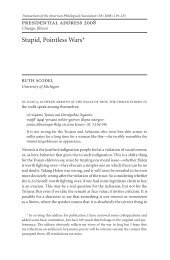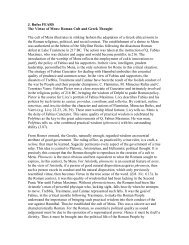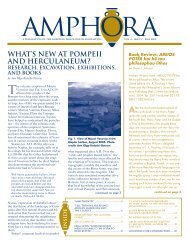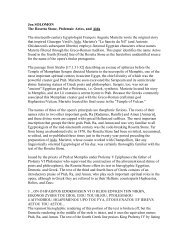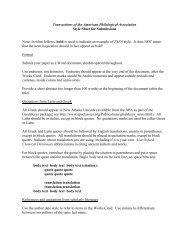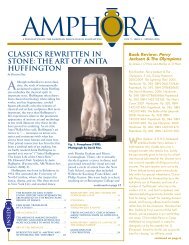Mary BACHVAROVA Homer's Iliad and the Hurro-Hittite Song of ...
Mary BACHVAROVA Homer's Iliad and the Hurro-Hittite Song of ...
Mary BACHVAROVA Homer's Iliad and the Hurro-Hittite Song of ...
You also want an ePaper? Increase the reach of your titles
YUMPU automatically turns print PDFs into web optimized ePapers that Google loves.
<strong>Mary</strong> <strong>BACHVAROVA</strong><br />
<strong>Homer's</strong> <strong>Iliad</strong> <strong>and</strong> <strong>the</strong> <strong>Hurro</strong>-<strong>Hittite</strong> <strong>Song</strong> <strong>of</strong> Release: Evidence for <strong>the</strong> Transmission<br />
<strong>and</strong> Translation <strong>of</strong> Mediterranean Epic in <strong>the</strong> Late Bronze Age<br />
In 1983 in Bogô azköy (Hiitite Hattusa), <strong>the</strong> first pieces <strong>of</strong> <strong>the</strong> bilingual <strong>Hurro</strong>-<strong>Hittite</strong><br />
<strong>Song</strong> <strong>of</strong> Release, were found. The <strong>Song</strong> <strong>of</strong> Release belongs to <strong>the</strong> same genre (SÌR) in<br />
Hattusa as Gilgamesh <strong>and</strong> Kumarbi, a precursor <strong>of</strong> Hesiod's Theogony. Dated to <strong>the</strong><br />
1400’s BC, it tells <strong>of</strong> <strong>the</strong> destruction <strong>of</strong> Ebla, which was conquered in approx. 1600 BC<br />
by an Old <strong>Hittite</strong> king. The poet blames this on <strong>the</strong> wrath <strong>of</strong> <strong>the</strong> Hurrian Stormgod<br />
Tessub, angered when <strong>the</strong> Eblaites refused to release certain captives from <strong>the</strong> town<br />
Ikinkalis. With <strong>the</strong> publication <strong>of</strong> Erich Neu’s Das hurritische Epos der Freilassung I:<br />
Untersuchungen zu einem hurritisch-hethitischen Textensemble aus Hattusôa (1996), <strong>and</strong><br />
<strong>the</strong> English translation <strong>of</strong> all <strong>the</strong> coherent pieces included by Harry A. H<strong>of</strong>fner Jr., in his<br />
2 nd edition <strong>of</strong> <strong>Hittite</strong> Myths (1998, pp. 65-77), this text can now be compared to o<strong>the</strong>r epic<br />
poetry <strong>of</strong> <strong>the</strong> ancient Mediterranean. The plot <strong>of</strong> <strong>the</strong> ‘assembly’ scenes (KBo XXXII.15,<br />
16, 19) can be compared to <strong>the</strong> opening scenes <strong>of</strong> <strong>the</strong> <strong>Iliad</strong>, in which two speakers argue<br />
over freeing captives <strong>and</strong> compensation. The very Greek motif <strong>of</strong> two humans arguing<br />
before an assembly <strong>of</strong> o<strong>the</strong>r humans, although built up out <strong>of</strong> stock Near Eastern motifs,<br />
does not appear with all its parts in any o<strong>the</strong>r Near Eastern narrative poem. (Also<br />
compare <strong>the</strong> proemium (11), hospitality sequences (13, 46, 65, 72, 209), <strong>and</strong> awakening<br />
for a message (37) to <strong>the</strong> <strong>Iliad</strong>.) Martin West, in The East Face <strong>of</strong> Helicon (1997), has<br />
presented <strong>the</strong> latest syn<strong>the</strong>sis <strong>of</strong> all we know about <strong>the</strong> ancient Greeks' debt to Near<br />
Eastern poetry; however, West couldn't fully include this text in his masterly study. The<br />
bilingual <strong>Song</strong> <strong>of</strong> Release in fact sheds new light on how <strong>the</strong> <strong>the</strong>mes, plot lines, motifs<br />
<strong>and</strong> formulae <strong>of</strong> courtly epic could have been translated <strong>and</strong> transmitted from <strong>the</strong> larger<br />
Near East to Greek speakers.<br />
In <strong>the</strong> Late Bronze Age, <strong>Hittite</strong>s were having <strong>the</strong> right kind <strong>of</strong> contact to allow <strong>the</strong> spread<br />
<strong>of</strong> songs <strong>and</strong> religious customs back <strong>and</strong> forth between Greeks, Trojans <strong>and</strong> <strong>Hittite</strong>s, <strong>and</strong><br />
<strong>the</strong> <strong>Song</strong> <strong>of</strong> Release shows us how a bilingual poet could actually transfer a poem from<br />
one linguistic group to ano<strong>the</strong>r. Homeric characters, such as Aleks<strong>and</strong>u <strong>of</strong> Wilusa<br />
(=Ilion), interacted with <strong>the</strong> <strong>Hittite</strong> court <strong>and</strong> came into conflict with Ahhiyawans (=<br />
Achaeans) (CTH 76). The incipit <strong>of</strong> a Luvian song concerning ‘steep Wilusa’ (CTH<br />
772,1.46) shows <strong>the</strong> importation <strong>of</strong> songs about Troy with Homeric formulae along with<br />
a cult. An oracular inquiry (KUB V 6 ii 57’, 60’) asking how <strong>the</strong> king should welcome<br />
<strong>the</strong> gods <strong>of</strong> Lazpa (=Lesbos) <strong>and</strong> Ahhiyawa, shows transfer <strong>of</strong> Greek cult to <strong>Hittite</strong>s,<br />
while mention <strong>of</strong> a Potniya Aswiya (’lady <strong>of</strong> <strong>the</strong> [Anatolian] l<strong>and</strong> <strong>of</strong> Assuwa’) in Linear<br />
B could be evidence <strong>of</strong> transmission <strong>of</strong> Anatolian cult to Myceneans (p. 203, with earlier<br />
refs., Calvert Watkins, ‘Homer <strong>and</strong> <strong>Hittite</strong> Revisited’, pp. 202 -11 in Style <strong>and</strong> Tradition:<br />
Studies in honor <strong>of</strong> Wendell Clausen, edd. P. Knox, C. Foss, 1998). The <strong>Song</strong> <strong>of</strong> Release<br />
too could have been imported to Hattusa along with <strong>the</strong> Hurrian cult <strong>of</strong> Tessub, <strong>and</strong> only<br />
translated when Hurrian was no longer viable <strong>the</strong>re. Besides <strong>the</strong> correspondences<br />
between <strong>the</strong> SÌR genre <strong>and</strong> Homeric poetry, <strong>Hittite</strong> funerary customs (CTH 450) are<br />
remarkably Homeric <strong>and</strong> <strong>the</strong> <strong>Hittite</strong> Ritual for <strong>the</strong> Infernal Deities (CTH 446) is very like<br />
<strong>the</strong> necromantic episode from Odyssey XI. The evidence thus justifies taking a closer<br />
look at contact originating within ‘Mycenaean’ Anatolia as a likely mechanism <strong>of</strong>
transfer <strong>of</strong> several sets <strong>of</strong> Homeric names <strong>and</strong> motifs to Greeks from <strong>the</strong> Near Eastern<br />
tradition.


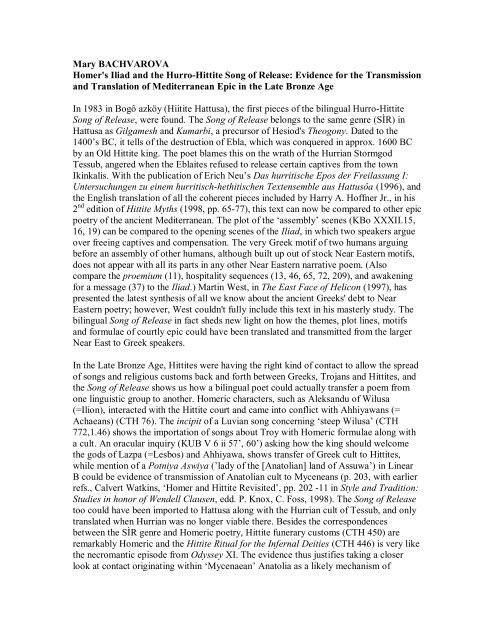
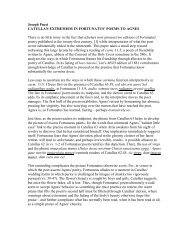
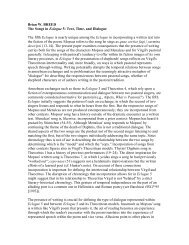
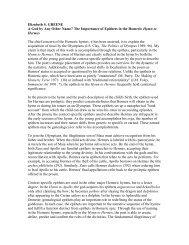

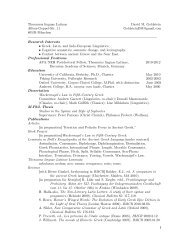

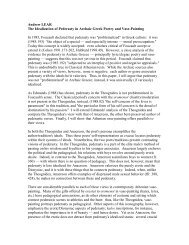
![John H. STARKS, Jr. [vo]cales vultus:Pantomime Actresses in Latin ...](https://img.yumpu.com/11930335/1/190x245/john-h-starks-jr-vocales-vultuspantomime-actresses-in-latin-.jpg?quality=85)
